Surfer SEO Review: Features, Pricing and More
This is my complete review of the on-page optimization tool, Surfer SEO.
In my review I’ll cover:
- How Surfer SEO works
- Important features
- Things to improve
- How it compares to Clearscope
So without further ado, let’s get started.
What Is Surfer SEO and What Does It Do?
Surfer is a tool designed to help SEO-optimize written content, like blog posts and articles.
It works by analyzing the content of a page against “500+ on-page” signals.

It also has a built-in keyword research tool.
Now, I’ll get into the features of the tool in a minute.
But the basic gist is that you write a blog post. Use Surfer to analyze the first page SERPs for your target keyword.

Then, use that info that you get to optimize your page.
The idea here is that the first page results are ranking for a reason. And you can rank too if you copy the on-page SEO approaches that your competitors are already using.
With that, let’s get into the actual features.
SERP Analyzer: Detailed Breakdown of Google’s First Page
This is Surfer SEO’s main feature.
It’s basically a VERY in-depth breakdown of the SERPs for a given keyword.

In this breakdown you get data on:
- Average word count (aka content length)
- Keyword density and frequency
- Use of partial match keywords
- Hidden content
- Page speed
- Characters count in title tags
- Alt text
And a bunch more stuff.
I’ve personally tried (and reviewed) over 200 SEO tools. So it’s fair to say I’ve seen pretty much every feature under the sun.
And yes, I HAVE seen a lot of the data you’ll find in Surfer in other tools.
But Surfer goes into much more detail. And provides some data that I haven’t seen before.
For example, they actually show you how many words appear above the fold on a page.

The average number of H2 headings that appear on each page.

And how many links a first page result tends to have.

I think this data is interesting. And unique.
But is it useful?
I’m not 100% convinced. Here’s what I mean:
Let’s say you just wrote a blog post. And you want to make sure it matches the on-page SEO that content on the first page is already using.
Well, you pop that keyword into Surfer… and get this:

What do you do with all of this information? Should you match the number of H2s that your competition has? Or add hidden content just because it’s correlated with rankings for that keyword?
It’s pretty overwhelming.
Besides, on-page SEO is on-page SEO. There isn’t a separate Google algorithm for each keyword.
So why wouldn’t you include your target keyword in your title? Or not mention your keyword above the fold? This is stuff that you should do anyway.
Overall, I think the SERP Analyzer is pretty cool.
It has a lot of unique data points. Some of which are helpful.
But I think they should actually remove some of these data points. That way, they can help users focus on the stuff that actually matters.
Content Editor: LSI Keyword Finder
The Surfer Content Editor helps you outline and write content that’s optimized for search engines.

Specifically, it scans the content on the first page for LSI keywords. And helps you weave those into your content.
This feature also analyzes the content structure of the first page results… including word count, number of images, and average paragraph count.

Right off the bat, I found something I already really like: the fact that you can choose which pages on the first page that you want to analyze. And that they focus on the top 5 results by default.

Why is this a big deal?
Well, most content analysis tools scan the top 10 or 20 results. That always kind of bugged me. I’m like: “Why would I want to copy someone on the second page?”.
So I like that you can focus on the top 3, 5 or 10 results. Or even exclude one of the top ranking pages if you don’t want to include that in the analysis.
Other than that, the content editor is pretty straightforward.
You copy and paste your content into it. The tool tells you the exact LSI keywords that you need to add. And how many times to mention them.

They even suggest a few “Topics and questions to answer”.

These are pulled from Google’s “People also ask…” box. And are designed to help you plan out content creation for that topic.
Plus, you can share this report with writers… without them needing to login. That way, they can write the draft in Google docs. And optimize it there. Helpful.
After using this feature, I can say that it’s VERY well done. It’s easy to use. Has solid data. And you can customize it to your liking.
NLP: Sentiment Analysis
Surfer SEO has a built-in natural language processing feature.
This feature uses IBM’s Watson to find the sentiment of the search results.
At first I couldn’t get this feature to work properly.
For example, when I used the NLP analysis, I saw this:

The chart notes that the “sentiment” as .756. But I have no clue how to use this data. Or what it means.
I eventually figured it out. When you click on one of the results, you see a page’s “true density”. Along a set of related phrases. Here’s where they show you the NLP sentiment around each of them.
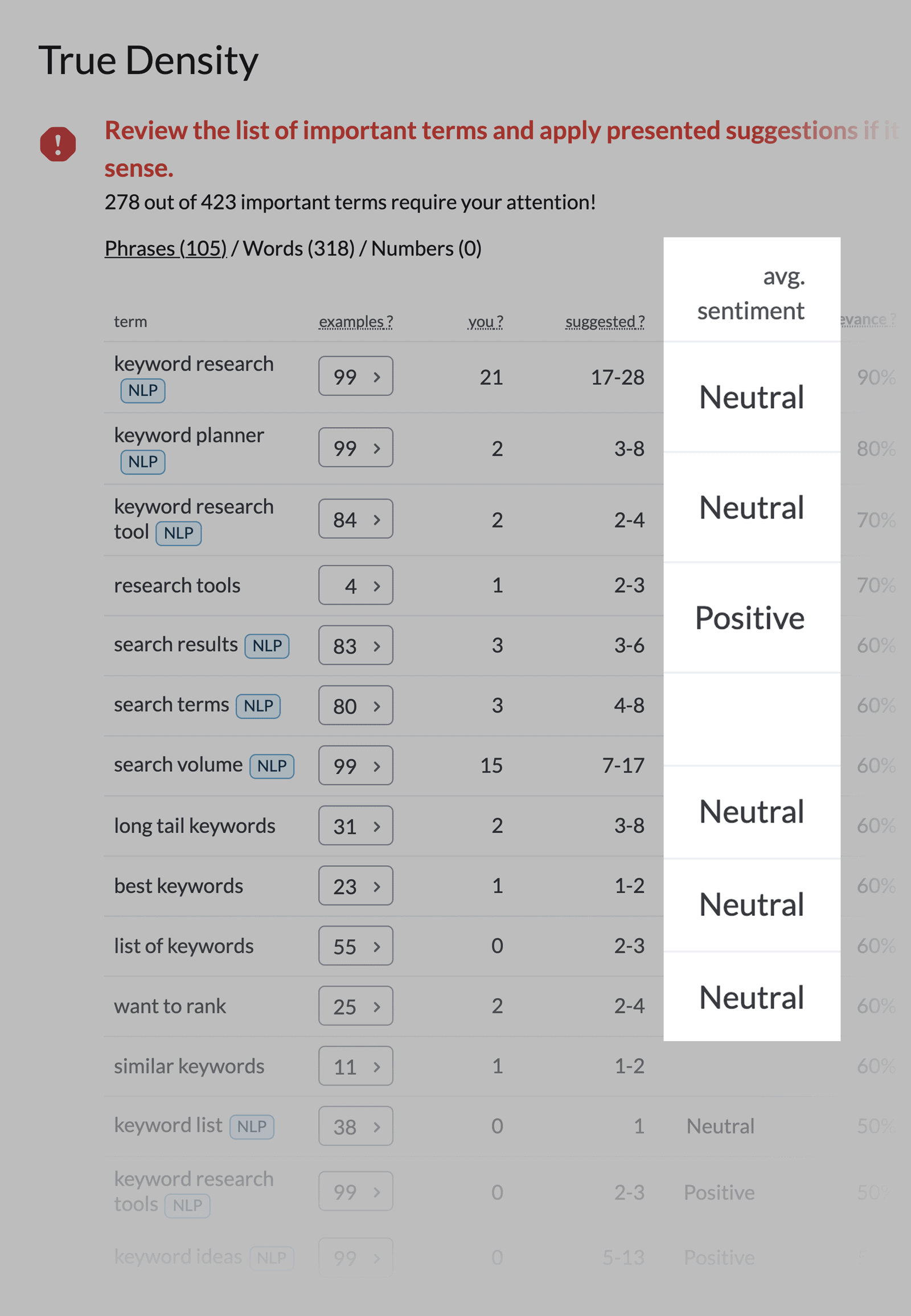
Honestly, I don’t understand why this is helpful. What does it matter if the sentiment of 100 related keywords are positive or negative? It has zero bearing on rankings.
Overall, this feature felt kind of forced.
Keyword Research: Find New Keywords to Target
Next, I wanted to try Surfer’s keyword research tool.
This works like pretty much any keyword tool on the market. Type in a seed keyword. And get a list of related keywords. Along with search volume.
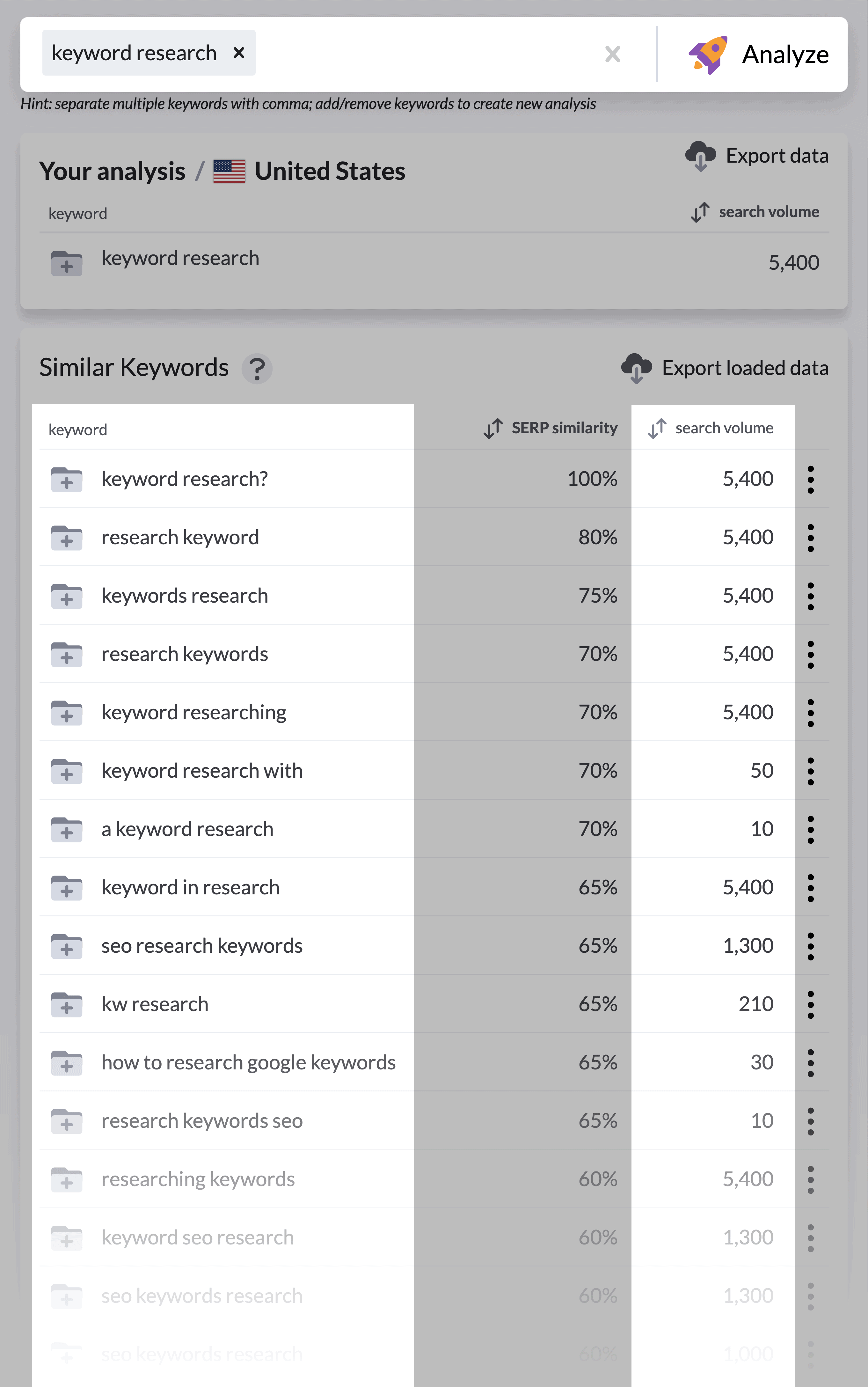
So: how is this feature overall?
On the plus side, it has a helpful feature that I’ve never seen in another keyword tool: “SERP similarity”.

This is basically how much overlap there is with the keyword that you typed into the tool.
For example, let’s say you used keyword A as your seed keyword. Well, if a lot of the pages that rank for keyword A also rank for keyword B, then keyword B will have a high SERP similarity.
Why is this helpful?
Well, it’s something tricky to know whether you should create different pages optimized around different long tail keywords. If the search results are different, then you probably should write a page for each keyword.
But if the SERPs are basically the same, it means that Google considers the two keyword synonyms. So you want to optimize one page around both terms.
This is a HUGE pain to do manually. Which is why I think “SERP similarity” is a cool, unique feature.
That said, I wish Surfer’s keyword research tool was more fleshed out. Specifically, it lacks a keyword difficulty score. Which is huge for choosing keywords to go after.
Surfer SEO Support
So at this point I tested out all of the key features in Surfer SEO. And it was time to see how their support stacked up.
Fortunately, asking a question to their support is easy: they have a little Intercom chat button at the bottom of every page.

And I decided to ask them kind of a tricky question. A question that I wanted to know the answer to: how does Surfer estimate domain traffic to a site?
I noticed this data point in their content editor. But there wasn’t a tooltip or explanation.
So here’s exactly what I asked:
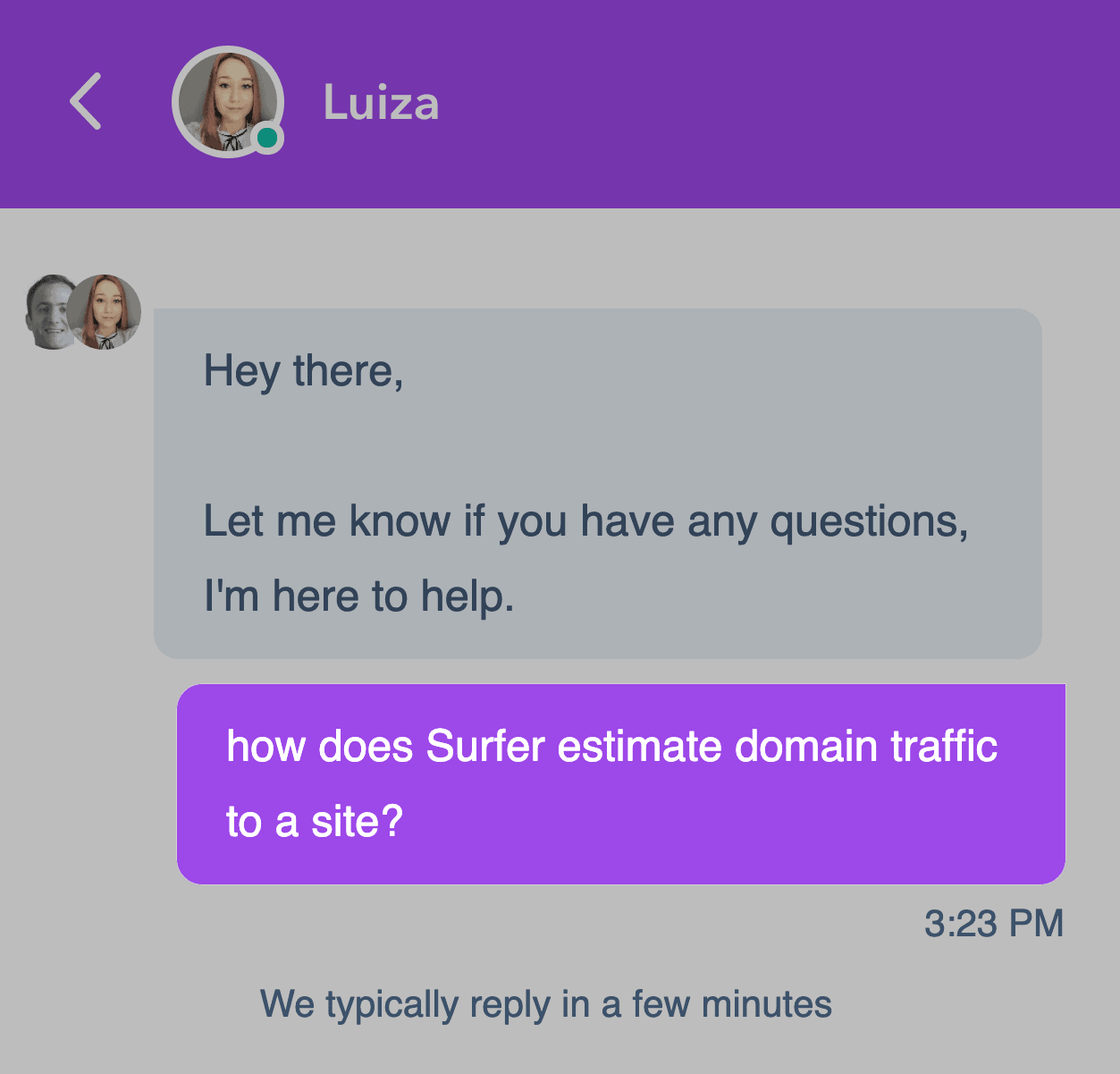
And their response:
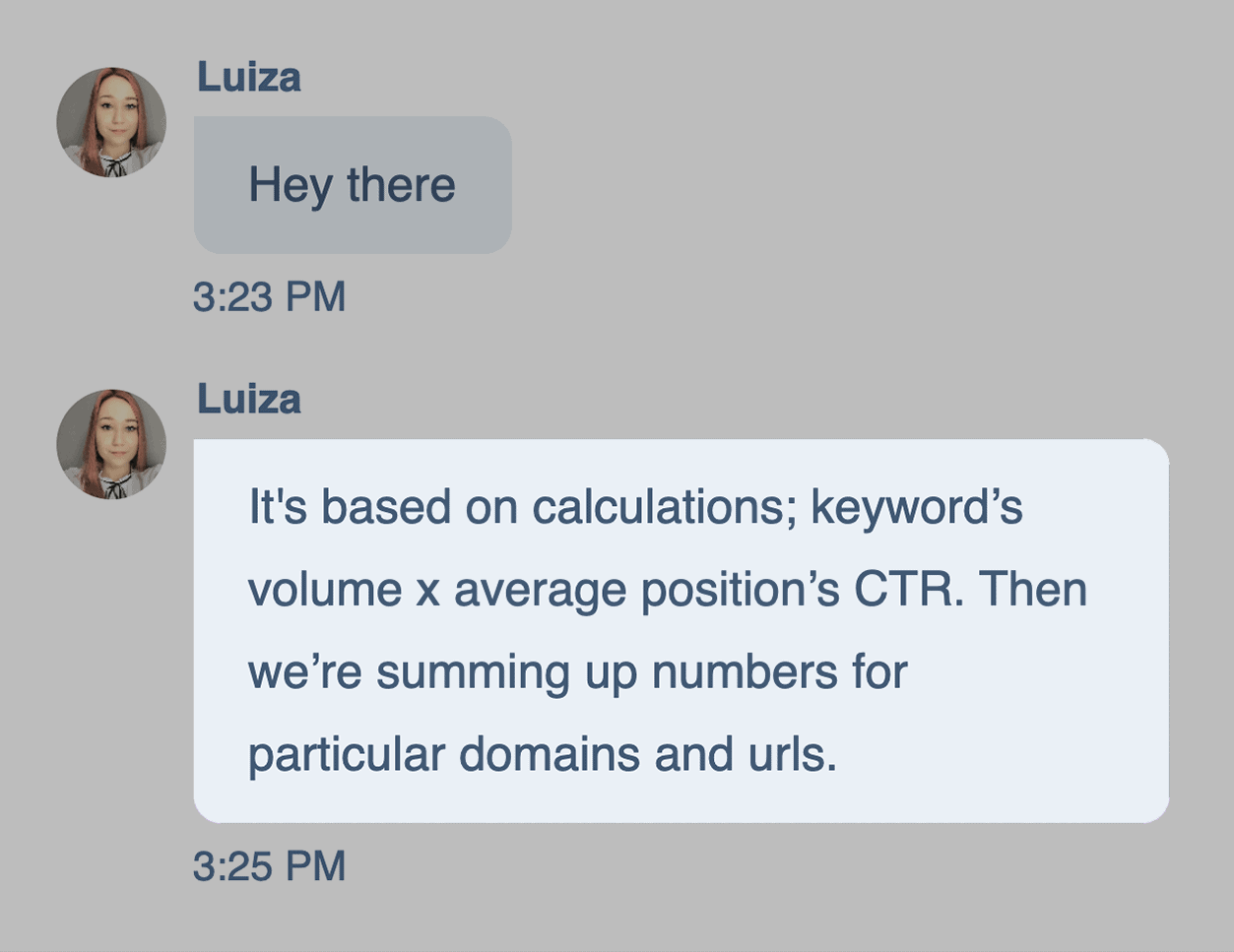
Needless to say, I was still confused. I still didn’t really understand where the actual source of the keyword’s search volume came from.
But to be fair, this is the same approach that most SEO tools (like SEMrush) use to estimate organic traffic to a site. So the overall approach isn’t that far off. But obviously, the execution leaves a lot to be desired.
In general, I’d say Surfer’s SEO support is “good not great”. I got a reply super quickly (good). But the initial response didn’t fully answer my question (bad).
That said, when I asked them to clarify, I got an honest, thorough response (good).
Surfer SEO Pricing
Here’s a breakdown of Surfer’s pricing:

If you go with monthly billing, you pay $29/month for “Hobby”, $59/month for “Basic”, $99/month for “Pro”, $199/month for “Business”, and $649/month for “Business Plus”. You save about 10% if you go for annual billing.
The features that you get access to are basically the same for each plan (with one major exception: the Hobby plan doesn’t come with page speed analysis). But you can run WAY more reports with the higher tier plans.
For example, you get 5 queries/day with Hobby. And 300 with Business Plus. That’s 60x more reports.
How does Surfer SEO’s pricing compare to similar tools?
Well, you really can’t compare a full-fledged SEO suite like Ahrefs with Surfer. Ahrefs has WAY more features.
Surfer basically ONLY does on-page SEO analysis. But it doesn’t have any features for backlink analysis, SEO site audits or rank tracking like Ahrefs has.
So I don’t think it’s fair to evaluate Surfer’s pricing based on an SEO software suite like Ahrefs. They’re two different tools.
But you CAN compare Surfer with its main competitor: Clearscope.
Clearscope has a flat pricing structure of $350/mo.
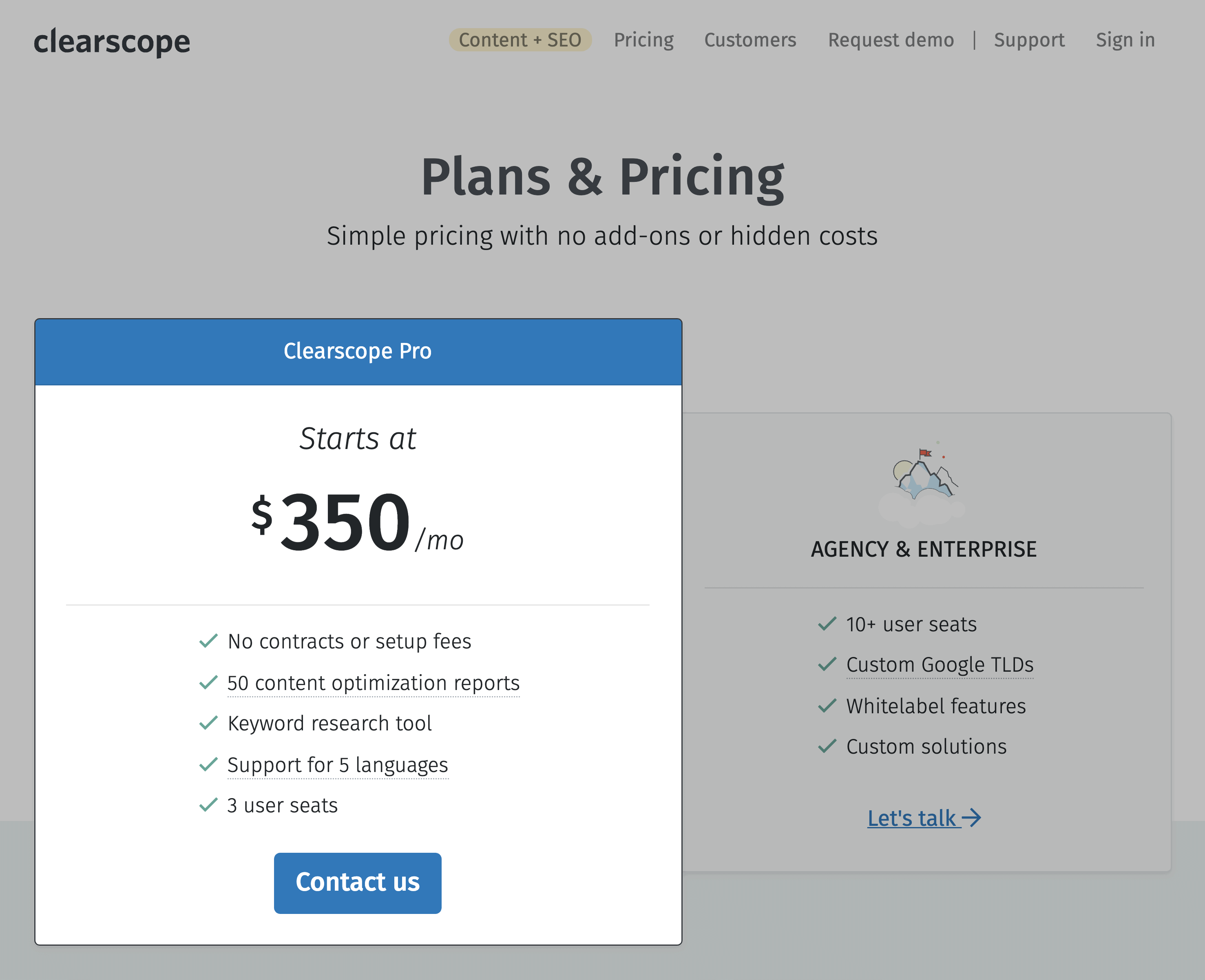
You get 50 searches per month with that. Surfer’s Pro plan costs $99/mo. Which is 3x cheaper.
Obviously the tools aren’t exactly the same. But they’re similar. So it’s fair to say that Surfer SEO is a really solid value compared to Clearscope.
Surfer SEO vs Clearscope
A lot of people ask me: “Which tool do you prefer? Surfer SEO or Clearscope?”.
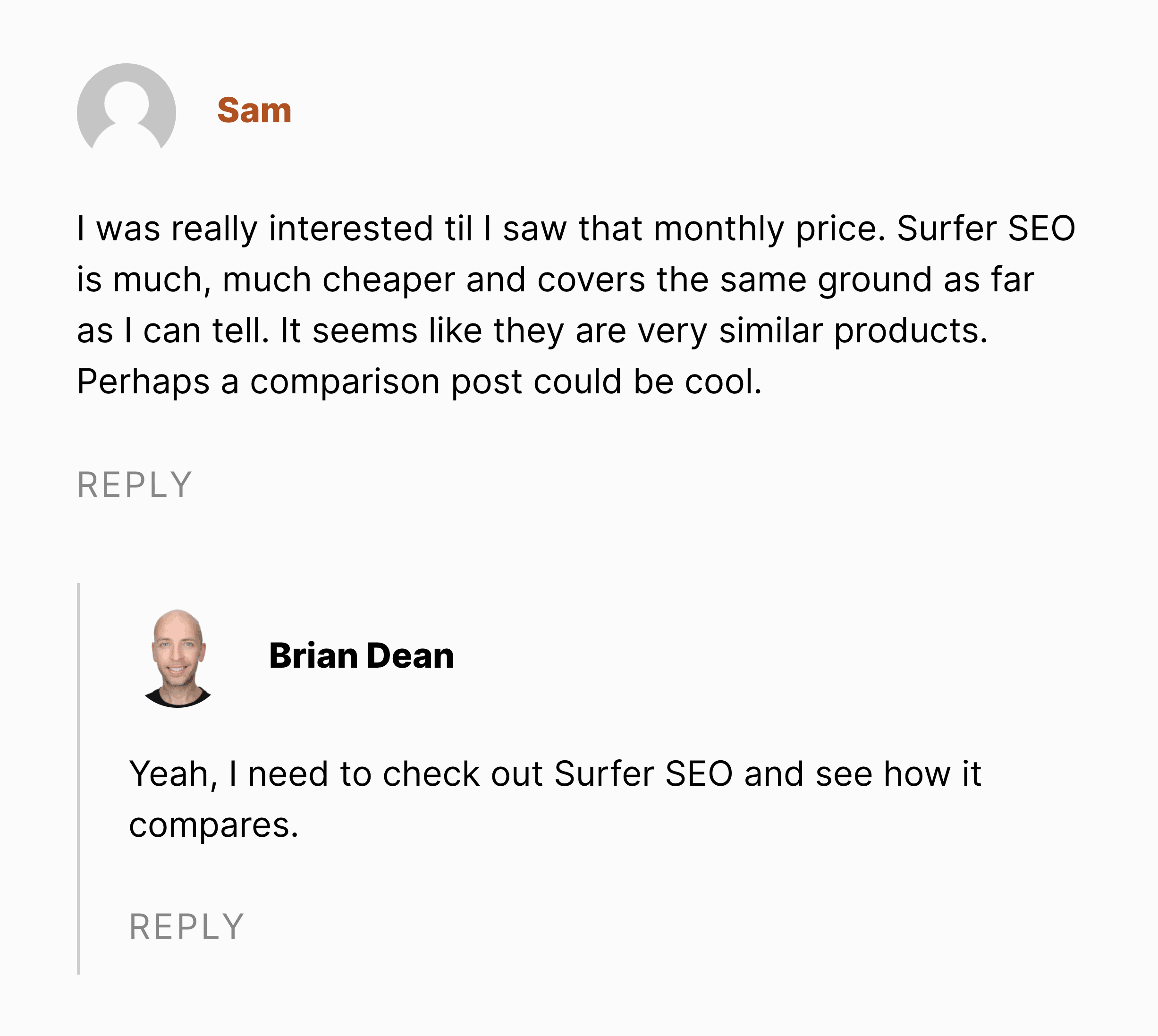
So I thought I’d quickly compare and contrast the two tools.
At a high level, both tools do essentially the same thing: scrape the current first page of Google’s search results. Show you the terms that show up most often on the top pages. And update in real-time as you tweak your content.
And both have a few differences. For example, Surfer has an extremely detailed SERP breakdown feature. And Clearscope also analyzes whether or not your page’s headers contains the keywords that they should.
Overall, I prefer Clearscope. But it’s close.
I like Clearscope’s UI much more than Surfer. It’s cleaner and easier to navigate. But most important of all, Clearscope gives your content an overall letter grade (and the average letter grade of your competition). Which helps you know where your content stands.
On the other hand, Clearscope is much more expensive than Surfer. So if you want the best value, definitely go with Surfer.
Things I Liked About Surfer SEO
Unique Data + Features: I was consistently impressed with the unique features and data that I came across in Surfer’s platform. It’s clear that the people behind it are legit SEO experts that “get” SEO. And they did a solid job of including features (like SERP similarity) that help SEO pros do their jobs.
Excellent Content Editor: Surfer’s Content Editor is AWESOME. Easily their best feature.
Great Value: The lowest tier plan costs $29/month. Yes, you only get 5 searches per month with that. But you can at least try out most of the tool’s key features.
Things That Surfer SEO Should Improve
Can’t Prioritize By Importance: I have a love/hate relationship with Surfer’s SERP Analyzer. I love the depth. But I hate how you’re presented with (literally) hundreds of variables. It’s not practical (or even useful) to try to optimize for all that stuff. They need to have a button where you can sort by the most important ranking factors.
Inaccurate data: Most of the data in Surfer was spot on. But I did run into some data that wasn’t totally on point. For example, they said that Backlinko gets more traffic than Moz.
I wish!
Pointless NLP Feature: I was seriously confused with why this feature is in the tool. It honestly feels like NLP was included as a way to make the tool seem more “advanced”.
Basic Keyword Tool: Their keyword research tool needs to be fleshed out a little bit more.
Surfer SEO Review: Is This Tool Worth It?
Overall, I think that Surfer SEO is worth a try.
It’s definitely not perfect. And could use some UI work. But if you’re looking for a tool to help you optimize your content, you really can’t go wrong with Surfer.
What Do You Think?
There you have it: my Surfer SEO tool review.
Now I’d like to see what you have to say.
Did you like it? Not like it? Think it was just ok?
Let me know in the comments section below.